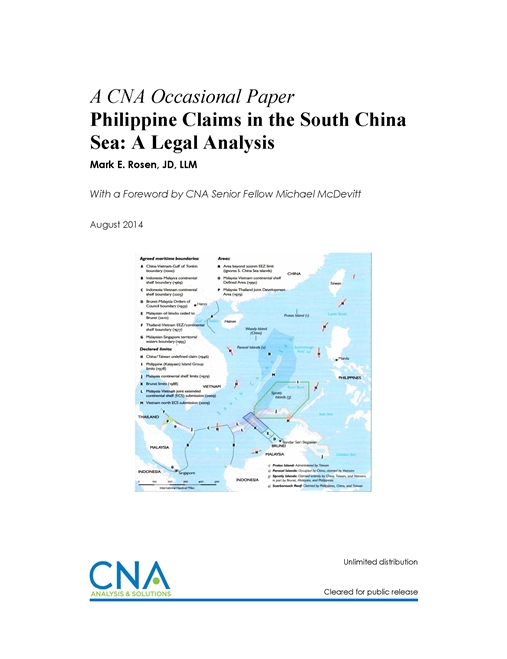The Philippine islands are at the center of current maritime disputes in the South China Sea (SCS). The Philippines has had maritime disputes with a number of countries, including the United States. Now, legal and policy attention is focused on sovereignty disputes between the Philippines and principally China in four areas: Scarborough Shoal; Second Thomas Shoal (the site of a beached former U.S. Navy LST); Reed Bank (or Reed Tablemount); and a variety of features in the Spratly island chain, in which the contestants also include Vietnam and the Republic of China (Taiwan). China’s assertion of its nine-dashed-line claim to the South China Sea in its 2009 filing with the UN Commission on the Limits of the Continental Shelf (CLCS) and its most recent actions to exclude Philippine fishermen from the waters around Scarborough Shoal emboldened the Philippine government to seek assistance from an international arbitration tribunal. It remains unclear whether the Chinese government will ever make an appearance before the Tribunal, or what the precedential effect of an adverse “judgment” would be, but this arbitration is an important development in the overall question of how these disputes will be decided and what the applicable rule set will be. Indeed, in the face of increasing tensions between Vietnam and China concerning China’s oil and gas activities in the vicinity of the Paracel Islands, numerous press reports say that Vietnam is considering joining the Philippine arbitration or initiating action on its own.
This paper will explore the legal and policy basis for the Philippines’ claims to features in the South China Sea with a focus on the areas listed above. Since the Philippines are geographically near most of the features in dispute, the task of examining the claims is complex: the claims are inextricably linked to the evolution of the Philippines as an archipelagic state pursuant to the 1982 UN Convention on the Law of the Sea (UNCLOS). The paper will also examine the entitlements of the Philippines to submerged features as part of its continental shelf.
This analysis will first examine the historical boundaries of the Philippine archipelago and the recent actions by the Philippines to conform its archipelagic claims to UNCLOS. It then will address the legal and historic basis of the Philippines’ claims to features in the South China Sea. Some discussion of the historic basis for the Philippines’ claims and the way in which its current boundaries were established is essential, since some of the claims to features outside of the Archipelago are predicated upon the fact that particular features lie upon the Philippine continental shelf. The analysis will conclude with a discussion of the pending arbitration and a possible template for joint development.
The focus is on two basic claims by the Philippine government: first, the claim to the features known as Scarborough Shoal; and second, the claim to the Kalayaan island group (KIG). The KIG encompasses a variety of notable features in the Spratly island chain, including (English variants) Reed Bank, Mischief Reef, Itu Aba, Second Thomas Shoal, and Fiery Cross Reef. These two claims differ in terms of both history and legal predicate. The KIG claim is loosely based on principles of discovery and effective occupation. Part of the KIG claim includes Mischief Reef, which is now occupied by forces from China. The bulk of the KIG claim is due west of Palawan Province in the Southern Philippines; it has some rich fishing areas as well as hydrocarbon resources near Reed Bank, which is in the eastern portion of the KIG claim. By contrast, the claim to Scarborough Shoal relies upon different historic facts. The Shoal is mostly submerged at high tide; some argue that it is thus part of the Philippine continental shelf and should be classified as a high-tide elevation and entitled to a 12-nm territorial sea. Regardless, the legal bases for these sovereignty claims will be examined. That analysis will be tempered, of course, by international law as it relates to the ability of states to appropriate wholly submerged, or low-tide elevations, as well the legal entitlements of states to rocks which appear at high tide. In doing so, it will take into consideration the countervailing arguments by Vietnam and China to sovereignty, in order to offer an objective assessment of which claims are superior.
Download reportDistribution unlimited. Specific authority contracting number: E13PC00009.
Details
- Pages: 66
- Document Number: IOP-2014-U-008435
- Publication Date: 8/1/2014
